First Looks: Adobe Creative Suite 5
This week's TechByter Worldwide was prepared using the CS5 version of Adobe Dreamweaver. The CS5 Master Collection is gigantic: The beta download took hours because it is 8.8 gigabytes and installing all of the applications adds a total of 21 items of the Start Menu. Because of the size and complexity of CS5, I'm not currently offering a review of the entire suite or even of any one application. Instead, I'll be telling you what I've found over the next several months. What I have for you this week is the first scouting report into CS5 territory.
Adobe has made two decisions that are sure to be criticized by people who don't know what they're talking about, so let me get them out of the way right now.
- Mac users will find that they cannot install CS5 on any Mac that doesn't have an Intel processor. Good decision. If you're serious enough about your work to use CS5, you're serious enough to have a current computer. After all, even Apple no longer supports non-Intel processors with new versions of their operating systems.
- If you want to do video production with Adobe After Effects, you'll need a 64-bit processor. You can't even install After Effects on a 32-bit system. Good decision. Video has been bumping up against the limitations of 32-bit systems for years. After Effects is a serious, professional tool. Professionals will have 64-bit systems and a lot of RAM. The performance difference is breathtaking.
Some applications (Photoshop, for example) are available in 32-bit and 64-bit versions; the installer will select the right version or, in the case of Photoshop, install both versions on 64-bit systems.
NOTE: I had intended to include the videos from the Adobe website in this review, but the code provided by Adobe to embed the videos caused Firefox to crash and the W3C reported more errors with the code than I had time to deal with.
Instead, I am providing a link to each of the videos and each will open in a new window.
Photoshop: Content-Aware Healing
Photoshop's Healing Brush, as helpful as it is, often gets things wrong. Adobe has now developed a Content-Aware Healing Brush and I don't have enough superlatives to explain why this is such a breakthrough feature.
I'll start with a video, provided by Adobe, in which product manager Bryan Hughes explains what content-aware healing can do.
Adobe always provides production samples so that tech journalists can follow the lesson plan and repeat what we've been shown. As helpful as those are, I always try to find something that offers a bit more of a challenge. The goal isn't necessarily to make the application fail, but to see if it performs as well in real-life situations as it did in the demo.
Click any of the smaller images for a full-size view.
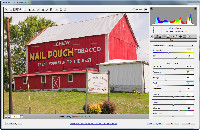 So here's the image I started with, a barn in Eastern Ohio's Amish country. The image is open in Camera Raw and I've improved the lighting and contrast a bit, just as I would have in the CS4 version of Photoshop. But look at all the power lines and that ugly power pole. With CS4, I might have been able to remove some of the problems by using the Clone Stamp, but it would have taken many hours and the changes would have been obvious.
So here's the image I started with, a barn in Eastern Ohio's Amish country. The image is open in Camera Raw and I've improved the lighting and contrast a bit, just as I would have in the CS4 version of Photoshop. But look at all the power lines and that ugly power pole. With CS4, I might have been able to remove some of the problems by using the Clone Stamp, but it would have taken many hours and the changes would have been obvious.
 I wanted to remove the power line on the right side of the barn. The process involves selecting the Content-Aware Healing Brush and drawing over the power line.
I wanted to remove the power line on the right side of the barn. The process involves selecting the Content-Aware Healing Brush and drawing over the power line.
 Removing the line took about 45 seconds, and that included a few second passes with the tool at a few leftover artifacts. I could have done this with the Clone Stamp, but not this well and not in 45 seconds.
Removing the line took about 45 seconds, and that included a few second passes with the tool at a few leftover artifacts. I could have done this with the Clone Stamp, but not this well and not in 45 seconds.
 Next I wanted to try a larger challenge: The utility pole at the left of the barn. This is the result of just the Content-Aware Healing Brush. I could have used the related Content-Aware Fill with similar results. Part of the house in the background has been duplicated and you can still see where the pole was, but as a starting point, this is a huge time saver.
Next I wanted to try a larger challenge: The utility pole at the left of the barn. This is the result of just the Content-Aware Healing Brush. I could have used the related Content-Aware Fill with similar results. Part of the house in the background has been duplicated and you can still see where the pole was, but as a starting point, this is a huge time saver.
 To finish the image, all I needed to do was a bit of additional work with the Clone Stamp and the Content-Aware Healing Brush.
To finish the image, all I needed to do was a bit of additional work with the Clone Stamp and the Content-Aware Healing Brush.
Working with a 10MB raw file on a 64-bit computer that has 8GB of RAM, the process required just slightly more than an hour.
 The beta version of Photoshop always has an amusing splash screen and the CS5 version is no exception.
The beta version of Photoshop always has an amusing splash screen and the CS5 version is no exception.
InDesign: Further Proof that Adobe Listens
Way back in 2004, my review of InDesign CS asked why InDesign still couldn't create text that spans columns. Shortly thereafter, I was summoned to Seattle and found myself in a conference room with the InDesign product manager and a dozen or so members of the InDesign development team. In my review, I had pointed out that although InDesign did a lot of things really well, it came up a bit short in some comparisons with Ventura Publisher.
For the next hour or so, I described tasks that I thought Ventura did better than InDesign. Questions were asked. Workflow was discussed. Notes were taken.
Since then, Adobe has released CS2, CS3, and CS4. Each new version offered new features and better ways to do things, but creating a multi-column head still required making a special frame for the headline, placing the headline in the frame, and re-arranging everything on the page. Each new version, that is, until now. And, as is typical of Adobe, the developers have reached further. They created an associated feature that I find delightful even though the need for it never occurred to me.
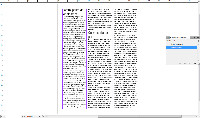 In CS4, headlines had to stay in their own columns...
In CS4, headlines had to stay in their own columns...
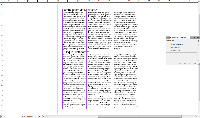 ... but in CS5, headlines can span columns. To create this effect, I simply set up a new paragraph tag that has a span-columns property set to "all". InDesign took care of re-flowing the text.
... but in CS5, headlines can span columns. To create this effect, I simply set up a new paragraph tag that has a span-columns property set to "all". InDesign took care of re-flowing the text.
Besides being able to have a paragraph span more than a single column, it's possible to format collection of paragraphs into multiple columns within a single column. Why? Think short bulleted list.
Here's a short video with Adobe Group Product Manager Michael Ninnes that explains how these features work.
That's probably the least exciting new feature of InDesign, but it's one that I've been watching for. As Michael Ninnes says in the video, this was a much-requested addition. Even so, I feel a tiny bit responsible for this one and it was definitely worth the wait.
I'll cover InDesign in more detail in a later program.
Painting with Vectors
There are 2 kinds of graphics: raster/bitmap/pixel and vector. Raster-based applications such as Photoshop produce photo-realistic images and vector-based applications such as Adobe Illustrator produce images that can be scaled to any size without suffering an attack of the jaggies. Everybody knows this just as everybody once knew that the world was flat.
The world is no longer flat. And Adobe Illustrator now has the Bristle Brush feature.
I am not an artist, so I'll yield the floor to Adobe Illustrator Senior Product Manager David Macy for an explanation.
Here's something a bit more in my experience range: fixing ugly dashes.
Click any of the smaller images for a full-size view.
 Sometimes when you're working with text, you might need a dashed outline, but the dashes don't align properly at corners. I've never found an application that can help with this until now. The image at the right is is my starting point.
Sometimes when you're working with text, you might need a dashed outline, but the dashes don't align properly at corners. I've never found an application that can help with this until now. The image at the right is is my starting point.
 Here I've converted the text to outlines (paths) and have applied a dashed outline. Be sure to click the image so that you'll see the larger version. Notice how the dashes are particularly problematic on the letters H, I, and T.
Here I've converted the text to outlines (paths) and have applied a dashed outline. Be sure to click the image so that you'll see the larger version. Notice how the dashes are particularly problematic on the letters H, I, and T.
 Illustrator now has an automatic dash adjustment option that will fix most problems without any need for your intervention. I've used text to illustrate this because it makes the problem painfully obvious, but dash adjustment will be even more useful for non-text applications.
Illustrator now has an automatic dash adjustment option that will fix most problems without any need for your intervention. I've used text to illustrate this because it makes the problem painfully obvious, but dash adjustment will be even more useful for non-text applications.
A Bridge to Everywhere
 Adobe Bridge is one of the most useful utility applications in the CS4 suite and it's even better in CS5: Now there's a Mini-Bridge that you can open within the various applications. Here you're seeing it inside Photoshop.
Adobe Bridge is one of the most useful utility applications in the CS4 suite and it's even better in CS5: Now there's a Mini-Bridge that you can open within the various applications. Here you're seeing it inside Photoshop.
The Mini-Bridge makes it easy to find and open images in Photoshop or Camera Raw. You can also switch to the full-size version of Bridge if you want to.
Previously, with an overloaded 32-bit computer, I elected not to have Bridge start with Windows. Now that I'm running a 64-bit version of Windows on a machine with a reasonable amount of memory, I'm rethinking that decision.
Even the Installer is Better
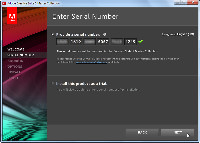 First you need to provide the appropriate serial number. One obvious improvement here is that the number is large and easy to see.
First you need to provide the appropriate serial number. One obvious improvement here is that the number is large and easy to see.
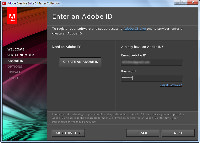 You'll then be asked to set up an Adobe ID. This is what you'll use for Adobe Live CS, or if you need support from Adobe.
You'll then be asked to set up an Adobe ID. This is what you'll use for Adobe Live CS, or if you need support from Adobe.
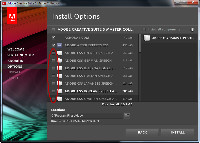 By default, everything is marked to be installed, including the voice recognition files for many languages. I deselected these. By default, After Effects will be deselected on 32-bit machines and if you try to select it, you will be told that After Effects works only on 64-bit machines.
By default, everything is marked to be installed, including the voice recognition files for many languages. I deselected these. By default, After Effects will be deselected on 32-bit machines and if you try to select it, you will be told that After Effects works only on 64-bit machines.
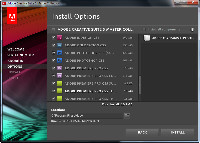 If you have a previous version of Adobe Creative Suite installed, CS5 will leave the previous version alone. In some cases (Dreamweaver, for example) settings will be brought over from the previous version.
If you have a previous version of Adobe Creative Suite installed, CS5 will leave the previous version alone. In some cases (Dreamweaver, for example) settings will be brought over from the previous version.
 At this point, you might conclude that it's time to go out for lunch, but the installation took only about 30 minutes.
At this point, you might conclude that it's time to go out for lunch, but the installation took only about 30 minutes.
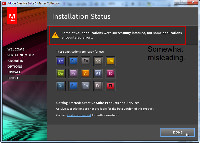 My sole complaint is this message at the end of the installation. I was warned that something had failed, but wasn't told what. I started the installer again so that I could see which component had failed to install. The only components missing were the language files that I had omitted intentionally.
My sole complaint is this message at the end of the installation. I was warned that something had failed, but wasn't told what. I started the installer again so that I could see which component had failed to install. The only components missing were the language files that I had omitted intentionally.
Making Flash Accessible: Flash Catalyst
No matter how you slice it, working with Flash has never been easy. The interface just hasn't been intuitive, even to people who spend a lot of time with time-based graphics (formerly known as animation). Flash Catalyst makes it possible for designers to create basic Flash graphics and, unlike applications with similar goals from other companies, Flash Catalyst offers the ability to create files that can then be opened in Flash and modified, not just played.
Because the target audience for Flash Catalyst is designers, users may start new projects from a Photoshop file or an Illustrator file. In the past, the designer would mock-up a site in one of those programs and then send it to the Flash coder who would have to recreate everything in Flash. Now the designer can start the project.
I'd like to show you some samples from Flash Catalyst (and from some of the other components) but that's all going to have to wait until another time. As I said, this is a huge suite of applications and it's going to take more than a few programs even to cover the basics.
What's in There and How Much Does it Cost?
As with most other companies, Adobe shows prices as $2599 instead of $2600. As usual, I have rounded the price to the closest $10.
All of the applications shown are CS5 versions, except as noted.
DS = Design Standard
DP = Design Premium
WP = Web Premium
PP = Production Premium
MC = Master Collection
| Component | DS | DP | WP | PP | MC |
| Photoshop Extended | • | • | • | • | |
| Photoshop | • | ||||
| Illustrator | • | • | • | • | • |
| InDesign | • | • | • | ||
| Acrobat 9 Pro | • | • | • | • | |
| Flash Catalyst | • | • | • | • | |
| Flash Professional | • | • | • | • | |
| Flash Builder 4 | • | • | |||
| Dreamweaver | • | • | • | ||
| Fireworks | • | • | • | ||
| Contribute | • | • | |||
| Premiere Pro | • | • | |||
| After Effects | • | • | |||
| Soundbooth | • | • | |||
| OnLocation | • | • | |||
| Encore | • | • | |||
| Bridge | • | • | • | • | • |
| Device Central | • | • | • | • | • |
| Dynamic Link | • | • | • | • | • |
| Retail | $1300 | $1700 | $1800 | $1900 | $2600 |
Upgrade prices depend on the suite you own and the suite you want to upgrade to. For a complete summary, see this PDF from Adobe. This document also includes prices for the individual components.
What's Out There:
Collaborating With Co-workers Wherever They Are
People that you work with may be in another area of the building, on another floor, across town, or halfway around the world. Adobe CS Live online services are designed to make collaborating with these people easy, regardless of where they are.
By linking your design and production tools to the connectivity of the Internet, CS Live online services accelerate publication reviews and improve the ability to test website design in various browsers. You can share your desktop with co-workers and discuss text, graphics, colors, and placement.
Adobe CS Live include Adobe CS Review, Acrobat.com, Adobe BrowserLab, SiteCatalyst
NetAverages, and Adobe Story. I'll describe these in greater detail on subsequent programs. They are available from within many of the CS5 applications.
Adobe CS Live is provided without charge for the first 12 months. After that, a monthly or annual subscription fee will apply. The fee hasn't yet been determined.
 Bottom Line: It's Too Early for a Cat Rating.
Bottom Line: It's Too Early for a Cat Rating.
There's no question that Creative Suite 5 will earn a high rating, but I haven't yet even worked with all the apps. What I've seen so far tells me that graphics professionals, publication designers, and photographers will be standing in line, salivating.
For more information, visit the Adobe website.
Worth the Hassle: 64-Bit Computing
Imagine this: You own a 1989 Yugo GV but you've suddenly come into a large sum of money and you trade your 1989 Yugo GV in for a 2010 Rolls Royce Ghost. What differences might you notice? I have never owned a Yugo GV (but I did once own a Fiat 128, which is what the Yugo was based on) and I have never owned, driven, or even been a passenger in any sort of Rolls Royce. But what I experienced in moving from a 32-bit operating system to a 64-bit operating system made me think of that comparison. In short, it has been astonishing.
For me, the primary advantage of 64-bit computing is the amount of addressable memory. A 32-bit system is limited to approximately 4GB of RAM, including memory used by the video subsystem. That means the operating system and applications will have somewhere between 2GB and 3GB of RAM available if you have 4GB installed.
I have a lot of applications running most of the time and the 32-bit version of Windows ran out of RAM. When that happens, the operating system swaps information that would like to be in RAM to the disk. At some point, the swapping becomes so frequent that the disk drive(s) become swamped by the constant swapping.
That's what was happening to me. The computer regularly ground to a halt. I blamed the Microsoft Indexing service. I blamed the Carbonite backup service. But regardless of what services I disabled, the problem persisted.
In a 64-bit environment, I haven't encountered the problem and that alone is almost enough to make the upgrade worthwhile.
When combined with the improvements realized by using 64-bit versions of applications such as Photoshop, it's an even easier decision. This week, for example, I made the mistake of cropping an image from the Franklin Park Conservatory to 800" by 600" at a 100-pixel-per-inch resolution. I meant 800 pixels by 600 pixels, of course, not 800 inches by 600 inches. Even so, the process started and, after several minutes, nearly completed. That would have resulted in an image 80,000 pixels wide and 60,000 pixels tall. A stupid request such as that on a 32-bit system would take days to complete, not minutes. But the overall rule should still be not to ask the computer to do something stupid.
What Doesn't Work?
- My Ipod doesn't work properly with the 64-bit version of Itunes. Although I might be able to update the system's BIOS to resolve this, my workaround has been to sync the Ipod with a notebook computer that runs the 32-bit version of Windows 7 and Itunes.
- A nearly antique HP Ipaq doesn't connect reliably to the 64-bit Windows 7 machine. This could be a hardware problem, a firmware problem, or a software problem; but the Windows Mobile device does connect reliably to my notebook computer. So I synchronize between home and office machines with the Ipaq and the notebook and then copy my Outlook file from the notebook to the desktop. This is clumsy, but it works.
- Google Calendar Sync doesn't work with 64-bit systems.
- I can't use Microsoft Groove on a 64-bit system because the features I want to use won't work. My workaround has been to use AllwaySync.
- Audio from the sound system's ASIO driver is not recognized by Adobe Audition, but I can record using a USB device with Soundbooth and then edit in Audition.
- There is no 64-bit driver for my Epson Perfection 3200 scanner. Although a third-party company has a $40 application that will fix the problem, I can run the scanner under Linux.
- WordPerfect 5.1 won't run under Windows 7 64-bit. Although this is true, there are ways to run WordPerfect 5.1 on a 64-bit Windows system. I have to wonder why anyone would want to do this, though. Even though I've loaded WordPerfect 5.1 on every computer I've owned since the mid 1980s, I haven't used it for more than 2 decades.
 Bottom Line: 64-Bit Operating Systems Are No Longer The Future.
Bottom Line: 64-Bit Operating Systems Are No Longer The Future.
Whenever you replace the computer you have now, replace it with a system that runs a 64-bit version of Windows and that can hold a lot of RAM (8GB is not excessive). This is particularly true if digital photography or digital video are important to you.
For more information, visit the TCR website. (TCR is the company that built my computer.)
Short Circuits
Test and Keep and Ipad? Yeah. Right.
 Sitting in my anti-spam inbox, a message promised that I could "test" an Ipad for a month and then, "as a reward", keep it for free. The website says 25,000 "beta" testers are needed. Why? The Ipad isn't a beta device any more. I noticed the stench of a rat, but the website is very convincing.
Sitting in my anti-spam inbox, a message promised that I could "test" an Ipad for a month and then, "as a reward", keep it for free. The website says 25,000 "beta" testers are needed. Why? The Ipad isn't a beta device any more. I noticed the stench of a rat, but the website is very convincing.
Except for a few trivial matters.
![]() The most critical concern I have is that there is no business model for beta testing a product that's already shipping. Apple has done all the testing it needs to do and will conduct future development based on feedback from those who bought the first edition Ipad. So who would hire a company to perform beta testing?
The most critical concern I have is that there is no business model for beta testing a product that's already shipping. Apple has done all the testing it needs to do and will conduct future development based on feedback from those who bought the first edition Ipad. So who would hire a company to perform beta testing?
Apple isn't behind this because Apple doesn't work this way. If Apple were to give away 25,000 Ipads, they would give them to tech writers like me. But Apple doesn't work that way, either. It's nearly impossible to pry test hardware out of Apple; if you do, the time you have to work with it is short and you do have to return it.
So I don't exactly want to say that this e-mail is a fraud, but I do want to point out that the site is registered to a company in the Bahamas.
Intel Flies Through the Ceiling
According to the computer industry, the recession is over. Intel’s first quarter results met the company's (and Wall Street's) expectations. In fact, it beat them.
Intel reported net income of $2.4 billion (42 cents per share) on revenue of a little more than $10 billion. That was up almost 45% from last year. Wall Street analysts had been expecting earnings of 38 cents per share on revenue of less than $10 billion.
I quote Intel's website: "The investments we're making in leading edge technology are delivering the most compelling product line-up in our history," said Paul Otellini, Intel president and CEO. "These leadership products combined with growing worldwide demand and continued outstanding execution resulted in Intel's best first quarter ever. Looking forward, we're optimistic about our business as Intel products are designed into a variety of new and exciting segments."
The corporate communications folks seem to think that blather such as that impresses people.
What happened is this: Companies that held off on purchases of computer hardware during the recession realized that now would be a good time to buy, so they bought. As a result of the increased demand for computers, Intel realized record profits.
Did HP Bribe the Russians?
Hewlett-Packard says it is cooperating fully with German and Russian authorities after Russian police raided the Moscow offices of HP. The company is accused of paying bribes to win Russian government contracts. Ouch.
HP executives are accused of paying nearly $11 million in bribes in 2003 to win a $48 million contract for equipment according to the Wall Street Journal. In addition to cooperating with Russian and German investigators, Hewlett-Packard is conducting its own internal investigation.
The company says that the investigation involves conduct from more than 6 years ago, conduct by employees who are no longer with the company. The probe began in 2009 after German tax authorities reviewed the books of a small company in the East German state of Saxony.


 The author's image: It's that photo over at the right. This explains why TechByter Worldwide was never on television, doesn't it?
The author's image: It's that photo over at the right. This explains why TechByter Worldwide was never on television, doesn't it?
